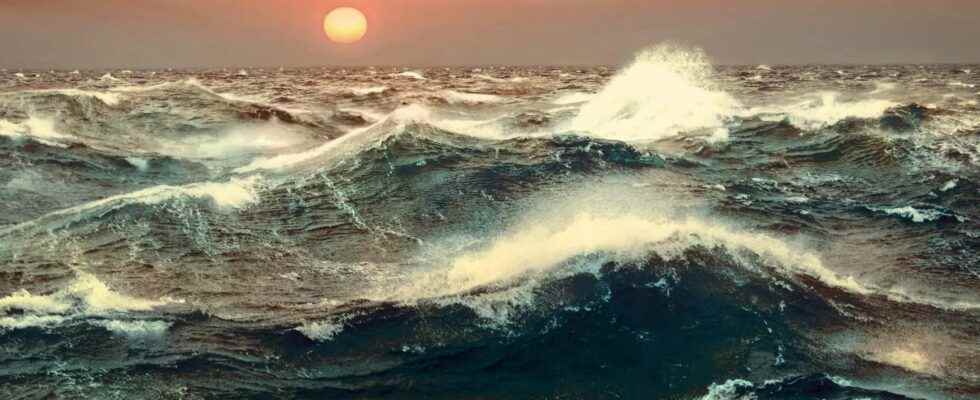We remember the event represented by the first photo of an exoplanetary system in 2008. It was about the imaging of exoplanets in motion around thestar HR 8799 taken by the astronomers Quebecer René Doyon, David Lafrenière and Christian Marois. Today it’s Charles Cadieuxa doctoral student from the University of Montreal, member of the Institute for Research on Exoplanets (iREx) who is being talked about with the international team he led and who is today publishing an article in the famous journal Astronomical Journal.
It is about a remarkable discovery as one can realize by reading the article in open access on arXiv and it will undoubtedly please the readers of theInccal, the famous French science fiction comic book scripted by Alexandro Jodorowsky and drawn by Mœbius. They’re sure to think of the prison planetAquaend since astronomers are now reporting the discovery just 100 light-years from Earth of what appears to be a planet ocean.
Representation of the exoplanet TOI-1452 b, a small planet potentially covered in water revealed by an international team of researchers led by Charles Cadieux, doctoral student at the University of Montreal and member of the Institute for research on exoplanets (IRex ). © Benoît Gougeon, University of Montreal
L’star pretender to this title is called TOI-1452 b and, as its name suggests (Tess Object of Interest YOU), he was initially flushed out by the NASA’s Tess satellite using the method of transit. This method provides a radius and a orbital period for an exoplanet. It can be completed by determining a mass using the radial velocity method. Masses and radii giving a density, we can then argue that an exoplanet is or is not an ocean planet if in addition it is at a distance from its host star making the existence of water possible in theory liquid — this is not self-evident because it is also necessary to take into account the existence of a atmosphere and of a possible greenhouse effect.
TOI-1452 b is in the constellation of the Dragon but before concluding that it was perhaps an ocean planet, it was necessary to verify already that it existed in orbit around one of the small stars of a binary system observed by Tesswith a size about 70% larger than the Earth and an orbital period around a red dwarf only eleven days.
The Mont-Mégantic Observatory is a world-class astronomical research facility located in the first International Dark Sky Reserve. You will soon be able to virtually visit it seated comfortably from your couch. Here is a taste! © Emir Chouchane, University of Montreal
Transits and Doppler shifts
Charles Cadieux and his colleagues first confirmed the transit occurrence with the Pesto camera (for planets Extra-Solar in Transit and Occultations) designed by David Lafrenière and his doctoral student François-René Lachapelle, both from the University of Montreal. It is installed on the telescope of the Mont-Mégantic Observatory, located in Estrie.
It remained to determine the mass and this was made possible with the spectropolarimeter infrared (SPIRou), an instrument developed in partnership notably by the University of Montreal and researchers from the Institut de Recherches en Astrophysics and Planetology of Toulouse. This spectrographinstalled in Hawaii on the Canada-France-Hawaii Telescope, allows radial velocity measurements in the infrared by doppler effect on low-mass stars with sufficient accuracy to detect Earth-sized planets in the habitability zone.
” The exoplanet TOI-1452 b is one of the best candidates for the title of “ocean planet” that we know. The planet’s radius and mass suggest a lower density than would be expected for a planet which, like Earth, is essentially made up of metals and rock “, explains Charles Cadieux in a press release from iREx.
Methods for detecting exoplanets have greatly diversified since the 1990s. They can be classified into two main categories, direct methods and indirect methods. The three main methods are the direct imaging method, the indirect transit method and the indirect radial velocity method. Discover exoplanets through our 9-episode web series. A video to be found every week on our Youtube channel. A playlist proposed by the CEA and the University of Paris-Saclay as part of the European research project H2020 Exoplanets-A. © CEA Research
An atmosphere and an ocean to study with the JWST?
” I am extremely proud of this discovery because it highlights the quality of astronomers and instruments here. Without the Mont-Mégantic Observatory, the SPIRou instrument designed in our laboratories and an innovative analysis method developed by our research staff, we would not have been able to uncover this unique exoplanet. “, always explains in the same press release on his side Rene Doyonprofessor at the University of Montreal and director of iREx and the Mont-Mégantic Observatory (OMM).
René Doyon being also the main researcher of NIRISSone of the four scientific instruments of the James Webb Space Telescope (JWST), he adds that “ observations with Webb will be essential to better determine more precisely the nature of TOI-1452 b. As soon as we can, we will request time to observe this strange planet “.
In this regard, it is interesting to know that, according to Mykhaylo Plotnykov and Diana Valencia of the University of Toronto, two specialists in models of the internal structure of exoplanets, the fraction of the water mass of TOI-1452 b could reach the 30%, which we are already seeing with some of the moons of Jupiter and Saturnas Ganymede and Enceladus.
It bodes well for theexobiology because, with a distance of only 100 light years from the Solar systemthe exoplanet is somehow within reach of the instruments of the JWST capable of characterizing its atmosphere.
—
LAST DAYS to take advantage of our summer offer.
Subscribe to our media for a period of 3 months and receive the Mag Futura as a gift!*
*Offer valid for any new 3-month subscription to the “I participate in the life of Futura” offer on Patreon.
—
Interested in what you just read?
